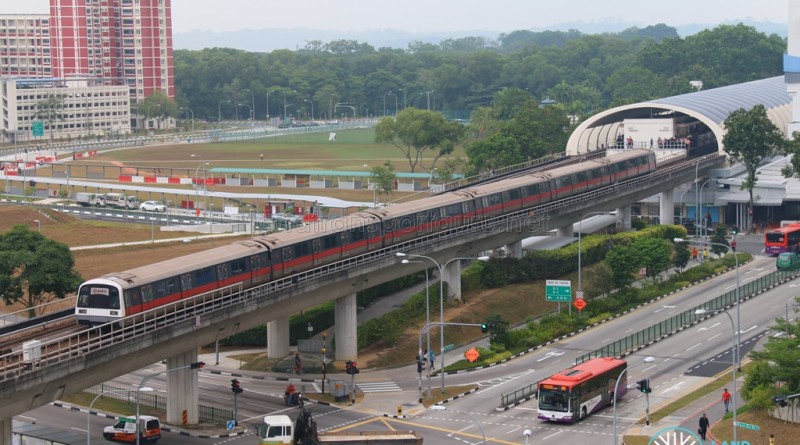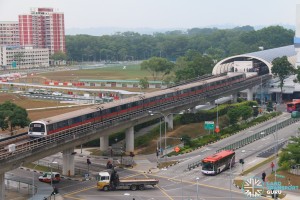The rail industry encountered a major setback on the morning of 22 March 2016 when two fatalities occurred on the East West Line. The deceased, both trainees recently employed by SMRT, were attending to a faulty trackside equipment near Pasir Ris Station when an oncoming train hit them. The train involved was Kawasaki Heavy Industries C151 Trainset 073/074, and the accident took place roughly 150m short of Pasir Ris Station (Platform B) at 11:08am. As a result, train services between Tanah Merah and Pasir Ris stations were disrupted for two and a half hours, and resumed at about 1:50pm.
Two ambulances, SCDF Vehicles and over 10 police cars were seen at the incident site. The station was shuttered, and a small crowd of onlookers were gathered around the station.
It is understood that 15 maintenance staff were walking towards the faulty ‘point machine’ roughly 200m away from the station, via a walkway 0.5m wide and alongside the tracks. The Operations Control Centre had granted permission for staff to access to track.
Power to the tracks was supposed to be switched off for maintenance to take place, but it did not happen in time. When the accident happened at around 11:10am, the incoming train was being driven in “Automatic Mode” at about 60 kilometres per hour, and the staff had walked about 150m away from the station, towards the faulty machine. The train driver was unable to stop the train in time to avoid a collision.
The two fatalities, Nasrulhudin Najumudin, 26 and Muhammad Asyraf Ahmad Buhari, 24, joined SMRT in January this year. They were undergoing on-the-job training when the incident happened.
Summary
- The accident occured on 22 March 2016 at 11:08am, resulting in the death of two maintenance staff.
- Train services between Tanah Merah and Pasir Ris stations were disrupted for two and a half hours.
- Staff were investigating an alarm for signalling equipment, and 15 staff were given permission to access the tracks to conduct maintenance.
- The group followed protocols and walked in a single file along the track walkway.
- Electricity to the track was not switched off when the group was on the track.
- An oncoming train hit 2 of the staff 150m away from Pasir Ris Station. The train was running in “Auto Mode” at about 60kmh.
- Investigations are ongoing.
Background
Pasir Ris Station (EW1) is the eastern terminus station of the East-West Line. Trains entering the station pass over a set of railroad switches that diverts them to either Platform A or Platform B, depending on which platform is already occupied by another train. In this case, the train involved had crossed from the eastbound track to the westbound track, headed for Platform B of Pasir Ris Station and putting it in the path of the maintenance team.
SMRT reported that carrying out maintenance on live tracks was routine practice with adequate safeguards to prevent a collision, such as informing the train driver in advance and proceeding past the maintenance team at reduced speeds.
Timeline of Events
With the timings and information provided by SMRT, the timeline of events are as follows:
- 8:08AM: A Signalling condition monitoring device installed along the tracks near Pasir Ris MRT Station registers a warning.
- 10:54AM: Authorisation is granted for the Permanent Way team and Signal team to move down from the station platform, cross the track, and access the maintenance walkway in order to proceed to the location of the device. A total of 15 staff were present.
- ~11:05AM: Trainset 073/074 approaches Pasir Ris Station from Tampines. The train is on an automatic mode, travelling at 60kmh, and will switch tracks before entering Pasir Ris Station at Platform B.
- The first group of five starts crossing the third rail, stepping on to the track in order to reach the point machine. According to SMRT’s records, they failed to carry out a key procedure of coordinating with the station’s signal unit to ensure that no trains enter the sector, which would have ensured their safety.
- Trainset 073/074 performs the track crossover before Pasir Ris Station. The train operator sees the maintenance team on the tracks and immediately applies the emergency brakes. Concurrently, the senior technical officer notices the approaching train and shouted “Train is coming!”
- At this point, the first three staff had crossed the third rail and were on the tracks. The first staff managed to jump onto the maintenance walkway and squatted, but the second and third staff did not manage to avoid the oncoming train.
- 11:08AM: Accident occurs. The second staff was crushed under the train while the third staff was flung about 5m away.
Response
Online response to this incident has been mostly of disappointment and grief, with blame directed towards SMRT for failing to ensure the safety of its workers and the mourning of the loss of two young men.
Saddened to learn about the deaths of two SMRT trainees today. My deepest condolences to their families.
We understand that faults and malfunctions do happen in our train system, and generally take them in our stride. But it is different when two young men lose their lives in a workplace accident.
SMRT is working with the police to investigate the matter, to find out how the accident occurred. Whether it turns out to be an unforeseeable mishap, an individual lapse or a system problem, we must do our best to ensure this does not happen again.
– Prime Minister Lee Hsien Loong (Facebook)I am extremely saddened by the tragic accident at Pasir Ris MRT station this morning, and would like to convey my deepest condolences to the families of the workers who were killed. The National Transport Workers’ Union will do what is necessary to support affected workers and their families during this difficult time. We must all do our part to keep each other safe at the workplace. Every accident is one accident too many. #SMRT #KeepSafe #GoHomeSafe”
– Chan Chun Sing, Secretary-General of the National Trades Union Congress (NTUC) (Facebook)
On 30 March 2016, the Ministry of Manpower issued the following interim instructions to SMRT, after consultation with LTA.
…when maintenance works are carried out during train service hours:
a) No trains should run in automatic mode for the sections of the track where personnel are required on the adjacent track walkway. Trains on such sections of the track should be operated manually, and at low speeds;
b) The section of the track where all works are taking place including maintenance or repair, should be isolated (i.e. no trains are allowed to approach) to provide a safe zone before any personnel is allowed to proceed to that area;
c) There should be robust authentication procedures between the personnel deployed on the tracks and the Operations Control Centre (OCC) to verify the track isolation;
d) Measures for isolation must be continuously in place until staff have left the work area and trackside; and
e) Watchmen should be deployed to alert personnel on the tracks of oncoming trains from both directions of the track.
Previous Accidents
Track intrusion incidents leading to injury or death are generally avoidable and preventable. Over the past decade, additional fences have been installed where the track can be accessed from bridge or ground level. Half-height platform-screen doors (HHPSDs) have been installed at all overground stations since March 2012, reducing the likelihood of accidental falls and discouraging suicides.
The last fatal accident happened in October 2012, where a dead body was found in the tunnel between Redhill and Tiong Bahru Stations (link). The person had climbed over a locked gate at Redhill station, and walked east along the tracks. Anti-climb barriers have since been installed at the station.
Prior to the installation of HHPSDs, numerous suicide cases took place at MRT station platforms. A notable case of accidental falling onto train tracks is that of Ms Nitcharee Peneakchanasak, who was hit by an oncoming train after falling onto the train tracks at Ang Mo Kio station on 3 April 2011. Her father sued SMRT and LTA for S$3.4m for the cost of her prosthetic legs, which was dismissed by the courts.
Gallery
References
- SMRT to review safety protocols after fatal accident near Pasir Ris Station, Yahoo News.
- SMRT fatal accident: We must do our best to prevent repeat, says PM Lee, CNA
- 2 SMRT staff dead in accident near Pasir Ris station, CNA
- ‘He was the light of any party’: Cousin of victim in SMRT accident, CNA
- Standard protocol for staff to use track walkways to investigate faults: CEO, CNA
- SMRT track accident at Pasir Ris: Trainee barely escaped as best friend was killed, The Straits Times
- SMRT acknowledges safety procedure not followed before fatal accident, CNA
- Safety lapse in track accident, says SMRT, The Straits Times

